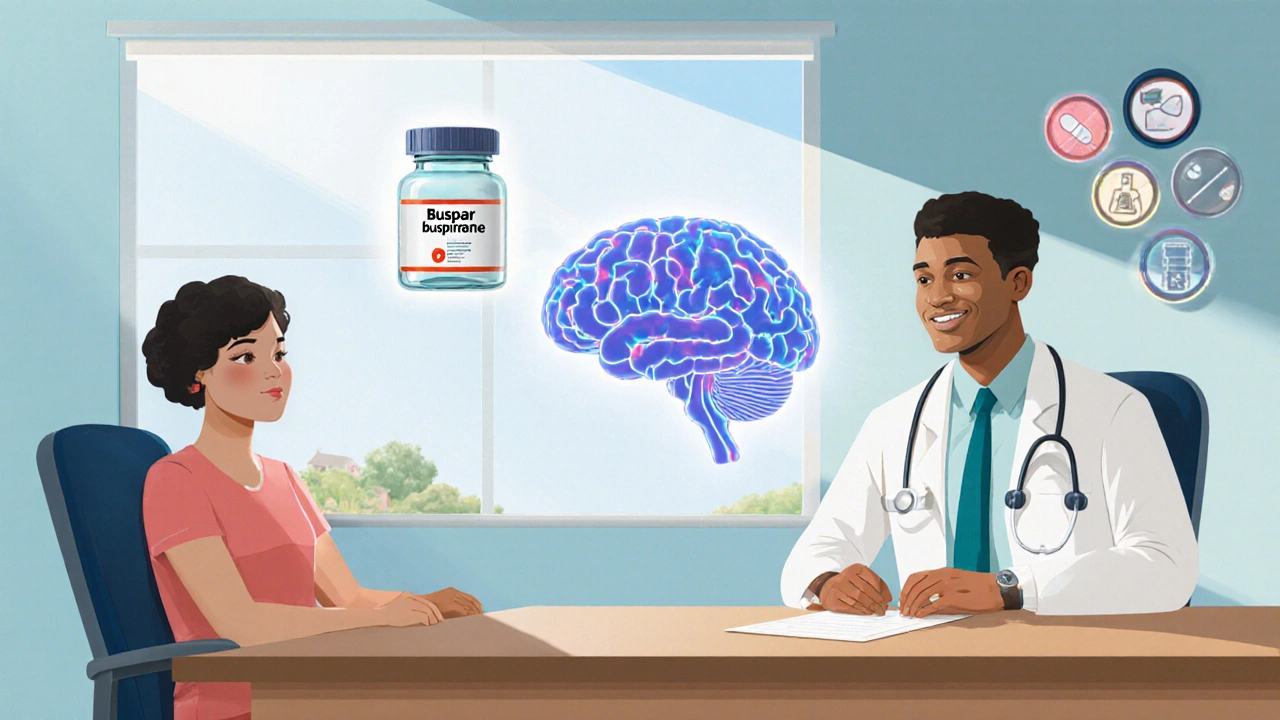Anxiety Treatment Decision Helper
Choose Your Symptoms and Preferences
Quick Take
- Buspirone (brand name Buspar) is a non‑benzodiazepine anxiolytic with low abuse potential.
- It takes 1-2 weeks to feel the full effect, making it better for chronic anxiety than panic spikes.
- Common alternatives include alprazolam, sertraline, hydroxyzine, propranolol, and cognitive‑behavioral therapy (CBT).
- Key differences revolve around onset speed, addiction risk, side‑effect profile, and suitability during pregnancy.
- Talk to your clinician about symptom patterns, medical history, and personal preferences before switching.
What Is Buspar (Buspirone)?
When you hear the name Buspar, it refers to the medication Buspirone a serotonin‑1A (5‑HT1A) receptor partial agonist used primarily for generalized anxiety disorder (GAD). It was approved by the FDA in 1986 and has become a go‑to option for people who need anxiety relief without the “high‑risk” profile of benzodiazepines.
Buspirone’s advantage lies in its minimal sedation and almost non‑existent dependence potential. However, you won’t feel an immediate calm; the drug builds up in your system, usually delivering noticeable relief after about ten days of consistent dosing.
How Buspirone Works and What to Expect
The molecule binds to serotonin receptors, gently nudging them toward a balanced state. Unlike benzodiazepines that boost GABA (the brain’s main calming neurotransmitter), buspirone takes a slower, steadier route. Typical starting doses are 5mg two to three times daily, with a maintenance range of 20-30mg per day. Because it’s metabolized by the liver enzyme CYP3A4, drugs that inhibit this enzyme (like ketoconazole) can raise buspirone levels and increase side effects.
Common side effects include light‑headedness, mild nausea, and occasional dizziness. Most people find these fade after the first week. Serious reactions-such as serotonin syndrome-are rare but possible if buspirone is combined with other serotonergic agents (SSRIs, MAOIs, certain migraine medicines).
Pros and Cons of Buspirone
- Pros
- Low abuse and dependence risk.
- Does not cause significant sedation or motor impairment.
- Can be combined safely with many antidepressants.
- Cons
- Delayed therapeutic onset (1-2 weeks).
- May be less effective for acute panic attacks.
- Potential interaction with CYP3A4 inhibitors.

Popular Alternatives to Buspirone
Below are the most frequently prescribed or recommended options when buspirone isn’t a perfect fit. Each entry includes a brief definition and key attributes.
Alprazolam a short‑acting benzodiazepine (brand name Xanax) that enhances GABA activity for rapid anxiety relief. It’s ideal for situational panic but carries a higher dependence risk.
Sertraline an SSRI antidepressant (brand name Zoloft) often prescribed for chronic anxiety and depression. Takes 4-6 weeks to work but has a well‑studied safety profile.
Hydroxyzine an antihistamine with anxiolytic properties (brand names Vistaril, Atarax) that can be used on an as‑needed basis. Causes mild sedation, useful for short‑term relief.
Propranolol a non‑selective beta‑blocker (brand name Inderal) that dampens the physical symptoms of anxiety like tremor and rapid heartbeat. Doesn’t address mental worry but works well for performance anxiety.
Cognitive Behavioral Therapy (CBT) a structured psychotherapy that teaches skills to reframe anxious thoughts and change behavior patterns. No medication side effects, but requires time and a trained therapist.
Side‑by‑Side Comparison
| Medication / Therapy | Drug/Class | Typical Onset | Addiction Risk | Common Side Effects | Pregnancy Safety |
|---|---|---|---|---|---|
| Buspirone | 5‑HT1A partial agonist | 7-14 days | Very low | Dizziness, nausea, headache | Category C (use if benefit outweighs risk) |
| Alprazolam | Benzodiazepine | 30 minutes - 1 hour | High (physical & psychological) | Sedation, memory issues, tolerance | Category D (avoid if possible) |
| Sertraline | SSRI antidepressant | 4-6 weeks | Low | GI upset, sexual dysfunction, insomnia | Category C (generally considered safe) |
| Hydroxyzine | Antihistamine (H1 blocker) | 15-30 minutes | Negligible | Dry mouth, drowsiness, blurry vision | Category B (relatively safe) |
| Propranolol | Beta‑blocker | 1-2 hours | None | Cold hands, fatigue, low blood pressure | Category C (use with caution) |
| CBT (therapy) | Psychotherapy | Weeks to months (skill acquisition) | None | Initial emotional discomfort | Fully safe |
How to Pick the Right Option for You
Choosing a treatment isn’t a one‑size‑fits‑all decision. Use the following decision tree as a quick self‑check:
- Do you need immediate relief for a panic attack? Alprazolam or Hydroxyzine can work within an hour.
- Are you worried about dependence or want a medication you can take long‑term? Buspirone, Sertraline, or Propranolol are safer choices.
- Is your anxiety tied to specific performance situations (public speaking, exams)? Propranolol or short‑acting benzodiazepines are often used only before the event.
- Do you prefer non‑pharmacologic routes or have a history of medication side effects? CBT or a blend of low‑dose meds and therapy may be ideal.
- Are you pregnant or planning a pregnancy? Discuss Sertraline or Propranolol with your OB‑GYN, as they have the most safety data.
Always bring these points to your clinician: symptom pattern, past medication experiences, other health conditions, and lifestyle factors (e.g., alcohol use, driving needs).
Questions to Ask Your Doctor
- What is the expected timeline for symptom improvement?
- How does this medication interact with my current prescriptions?
- What are the most common side effects I should watch for?
- If I need to stop, how should I taper to avoid withdrawal?
- Would adding therapy improve outcomes compared to medication alone?
Next Steps & Troubleshooting
If you start buspirone and feel no change after two weeks, don’t panic. Many clinicians increase the dose up to 30mg per day before labeling it ineffective. If side effects become intolerable, a short switch to hydroxyzine can bridge the gap while your doctor evaluates alternatives.
Conversely, if you experience excessive drowsiness on an SSRI, a low‑dose propranolol taken only during stressful events may balance mental and physical symptoms. The key is communication-track your mood daily, note any new symptoms, and share that log with your prescriber.

Frequently Asked Questions
Can I take buspirone and an SSRI together?
Yes, many doctors combine buspirone with SSRIs like sertraline to tackle both the emotional and physiological components of anxiety. The combination is generally safe because buspirone doesn’t significantly raise serotonin levels.
Why does buspirone take weeks to start working?
Buspirone modulates serotonin receptors gradually. Unlike benzodiazepines that boost GABA instantly, buspirone’s effect builds as the brain’s receptor balance adjusts, which typically needs 7-14 days of steady dosing.
Is buspirone safe during pregnancy?
Buspirone is classified as FDACategoryC, meaning animal studies showed risk but there aren’t enough human data. Doctors usually reserve it for pregnant patients only when the anxiety benefits outweigh potential risks.
How does propranolol help with anxiety?
Propranolol blocks the body’s adrenaline response, reducing tremors, rapid heartbeat, and shaking that often accompany performance anxiety. It doesn’t calm the mind directly, but the physical relief can lower overall worry.
When should I consider CBT instead of meds?
If you prefer a drug‑free approach, have a history of medication side effects, or want long‑term skill building, CBT is a strong first‑line option. Many studies show that CBT’s benefits can persist for years after treatment ends.

Tom Smith
September 29, 2025 AT 02:50Oh great, another bedtime story about pills.
Kyah Chan
September 30, 2025 AT 20:30The exposition suffers from a paucity of critical appraisal regarding the pharmacodynamic nuances of Buspirone relative to benzodiazepines. While the tabular comparison is thorough, the narrative neglects to address the heterogeneity of patient response profiles. Moreover, the omission of cost‑effectiveness analysis undermines the utility of the presented decision‑making framework.
Christopher Montenegro
October 2, 2025 AT 14:10It is intellectually negligent to promulgate the notion that Buspirone constitutes a panacea for chronic anxiety without interrogating the ethical ramifications of off‑label polypharmacy. The author’s cavalier endorsement of serotonergic adjuncts betrays a reckless disregard for the iatrogenic potential inherent in serotonergic syndrome. One must also contend with the epistemic void concerning long‑term neuroadaptive sequelae. Such omissions perpetuate a myopic therapeutic paradigm that privileges pharmaceutical convenience over robust, evidence‑based stewardship. The discourse would benefit from a rigorous, data‑driven interrogation of comparative efficacy metrics.
Kyle Olsen
October 4, 2025 AT 07:50Behold, the magnum opus of anxiety management-yet it reads like a drab PowerPoint left on a conference room table. The author has clearly misplaced the fulcrum of clinical insight.
Sarah Kherbouche
October 6, 2025 AT 01:30Honestly, this whole thing feels like a yankee copy‑paste job that ignores what actually works for us here. If you don’t give a damn about real‑world outcomes, spare us the fluffy brochure.
MANAS MISHRA
October 7, 2025 AT 19:10Thanks for the comprehensive overview! I appreciate the clear breakdown of onset times and side‑effect profiles. It really helps patients weigh the pros and cons in a concrete way. Also, the decision‑tree is a practical tool that many can apply during a clinic visit.
Lawrence Bergfeld
October 9, 2025 AT 12:50Great summary; concise; practical; consider discussing dosage titration with your prescriber; monitor for dizziness during the first week!
Chelsea Kerr
October 11, 2025 AT 06:30🤔 Navigating anxiety meds can feel like walking a tightrope, but remember you’re not alone. 🧠 Buspirone offers a low‑risk path, yet patience is key. Pairing it with CBT can create a synergistic effect that empowers you beyond the pharmacy shelf. 🌱 Stay curious, stay kind to yourself.
Tom Becker
October 13, 2025 AT 00:10Watch out-big pharma’s hidden agenda is lurking behind every “safe” label. They push Buspirone as the “no‑addiction” miracle while quietly funneling us into endless prescription cycles.
Laura Sanders
October 14, 2025 AT 17:50the article skips over the genetic polymorphisms that affect CYP3A4 metabolism which is a big oversight
Jai Patel
October 16, 2025 AT 11:30Hey folks, let’s dive deep into why picking the right anxiety tool is like choosing the perfect spice for a dish-too much of one can ruin the flavor, while the right blend lifts everything. Buspirone stands out because it’s a gentle whisper rather than a blaring siren, giving you calm without the crash that comes from benzodiazepines. First, think about the timeline: you’ll start feeling the subtle shift after about a week, which is perfect for those who can ride out the initial fog. Second, the side‑effect bouquet is light-just a hint of dizziness or nausea that fades fast, unlike the heavy sedation you might get from hydroxyzine. Third, because it doesn’t jam the GABA receptors, you stay sharp for work, school, or that evening salsa class you love. However, if you need a rapid fix for a panic surge, a short‑acting option like alprazolam or hydroxyzine is still the go‑to. For performance jitters, propranolol is the backstage crew that keeps your heart from doing a drum solo. CBT, on the other hand, is the rehearsal that builds your confidence long after the curtain falls. Combining Buspirone with an SSRI can be a power duet, covering both emotional and physiological beats. Just watch out for drug interactions-CYP3A4 inhibitors can turn a mild breeze into a storm, so always check your meds list. Pregnant listeners, chat with your OB‑GYN because the data is still a bit hazy, though Buspirone can be considered if the anxiety is severe. Cost matters too; generic Buspirone is often wallet‑friendly, whereas brand‑name alternatives can hit harder. Remember to track your mood daily; a simple journal can reveal patterns no clinician can see in a fleeting office visit. And if side effects become a nuisance, don’t hesitate to discuss a temporary bridge with hydroxyzine while you fine‑tune the dose. Ultimately, the best plan is a personalized mix of medication, therapy, and lifestyle tweaks-think exercise, breathing drills, and a solid support crew. Stay curious, stay proactive, and you’ll navigate the anxiety maze with confidence.